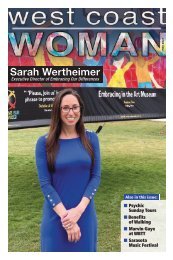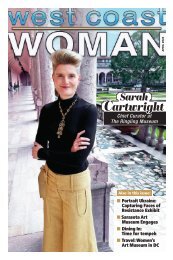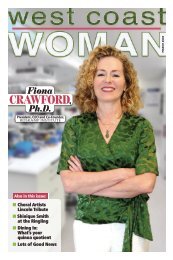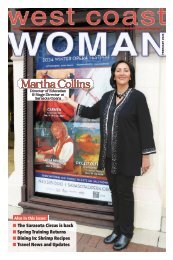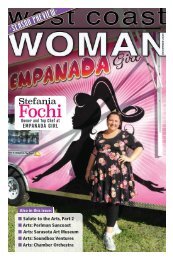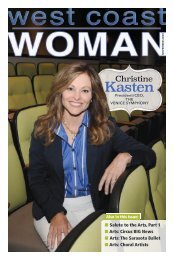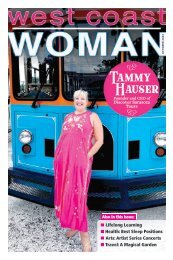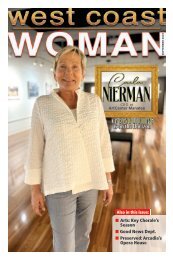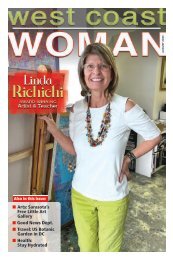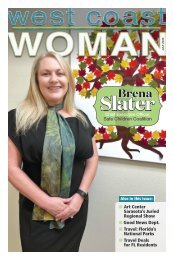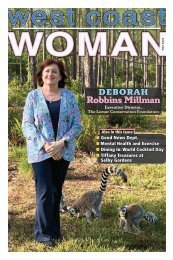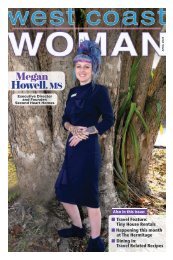wcw DECEMBER 2022
Create successful ePaper yourself
Turn your PDF publications into a flip-book with our unique Google optimized e-Paper software.
major art exhibits continued<br />
• Cubism and the<br />
Trompe l’Oeil at<br />
The Metropolitan<br />
Museum of Art<br />
At The Metropolitan Museum of<br />
Art, Cubism and the Trompe<br />
l’Oeil Tradition are presented in<br />
an entirely new understanding of Cubism<br />
by connecting it to the strategies, motifs,<br />
and playful provocation of trompe l’oeil<br />
(“deceive the eye”) illusionism.<br />
This transhistorical, international loan<br />
exhibition brings together more than 100<br />
objects, the majority being by the three<br />
Cubists who addressed the practice of<br />
trompe l’oeil in the years 1909-1915:<br />
Georges Braque, Juan Gris, and Pablo<br />
Picasso. Their paintings and collages<br />
(and, in the case of Picasso, sculptures)<br />
are paired with works by European and<br />
American artists from the 17th through<br />
the 19th century—from Samuel van<br />
Hoogstraten and Cornelius Norbertus<br />
Gijsbrechts, to Louis Léopold Boilly and<br />
William Harnett.<br />
Though these trompe l’oeil painters<br />
were often disparaged for merely copying<br />
nature, they filled their pictures with<br />
ingenious tricks and allusions, elevating<br />
the seemingly humble genre of still life.<br />
As the exhibit reveals, the Cubists both<br />
parodied and paid homage to classic<br />
trompe l’oeil devices, while inventing<br />
new ways of confounding the eye and the<br />
mind. Despite vast differences in overall<br />
appearance, both art forms interrogated<br />
the nature of representation, raising philosophical<br />
questions about the real and<br />
the fake, and the ephemeral and the enduring,<br />
that resonate powerfully today.<br />
Cubism and the Trompe l’Oeil Tradition<br />
unfolds across ten thematic rooms,<br />
charting the dialogue between Cubism<br />
and the past and the three-way competition<br />
between Braque, Gris, and Picasso.<br />
The exhibition includes an ensemble of<br />
collages and papiers collés (paper collage)<br />
by Braque, Gris, and Picasso, most<br />
of them rarely seen. Picasso’s Still Life<br />
with Chair Caning (1912)—the first Cubist<br />
collage—is displayed in the United<br />
States for the first time in 30 years.<br />
Information: www.metmuseum.org/.<br />
• Edward Hopper<br />
at The Whitney<br />
Edward Hopper’s New York runs<br />
through Mar 5, 2023 at The Whitney.<br />
The city of New York was<br />
Edward Hopper’s home for nearly six decades<br />
(1908–67), a period that spans his<br />
entire mature career and coincides with<br />
a historic time of urban development.<br />
Edward Hopper’s New York is the<br />
first exhibition of its kind to focus on<br />
the artist’s rich and sustained<br />
relationship with the city that<br />
served as the subject, setting,<br />
and inspiration for so many of<br />
his most celebrated pictures.<br />
The survey takes a comprehensive<br />
look at Hopper’s life<br />
and work through his depictions<br />
of the city—from his early impressions<br />
in sketches, prints,<br />
and illustrations, to his late<br />
paintings, in which New York<br />
served as a backdrop for his<br />
evocative distillations of urban<br />
experience.<br />
Drawing from the Whitney’s<br />
extensive holdings by the artist<br />
and amplified by key loans, the<br />
exhibition brings together many<br />
of Hopper’s iconic city pictures<br />
such as Automat (1927), Early<br />
Sunday Morning (1930), Room<br />
in New York (1932), New York<br />
Movie (1939), and Morning<br />
Sun (1952), as well as several<br />
lesser-known yet critically important<br />
examples including the<br />
artist’s watercolors of downtown New<br />
York and his painting November, Washington<br />
Square (1932/1958).<br />
The presentation also includes a variety<br />
of materials from the Museum’s<br />
recently acquired Sanborn Hopper<br />
Archive—printed ephemera, correspondence,<br />
photographs, and journals<br />
that together offer new insights into<br />
Hopper’s life. whitney.org/exhibitions/edward-hopper-new-york.<br />
• Looking Ahead…<br />
MoMA has Ed<br />
Ruscha/Now Then<br />
The Museum of Modern Art has<br />
ED RUSCHA / NOW THEN, the<br />
most comprehensive presentation<br />
of the artist’s work, and his first<br />
solo exhibition at the Museum, September<br />
23, 2023 through January 6, 2024.<br />
This is great timing for a fall 2023 visit in<br />
New York so you can plan ahead.<br />
Spanning 65 years of Ed Ruscha’s<br />
career and mirroring his own cross-disciplinary<br />
approach, the exhibition<br />
features over 250 works, produced<br />
from 1958 to the present, in various<br />
mediums—including painting, drawing,<br />
prints, film, photography, artist’s books,<br />
and installation—displayed according to<br />
a loose chronology.<br />
Alongside the artist’s most acclaimed<br />
works, the exhibition highlights lesser-known<br />
aspects of his practice, offering<br />
new perspectives on one of the most<br />
influential figures in postwar American<br />
art and stressing Ruscha’s role as a keen<br />
observer of a rapidly changing world.<br />
Raised in Oklahoma City, Ed Ruscha<br />
(American, born 1937) moved<br />
to Los Angeles in 1956 to<br />
study commercial art at the<br />
Chouinard Art Institute (now<br />
CalArts). Beginning with these<br />
formative years, the exhibition<br />
includes rarely seen paintings<br />
and works on paper made<br />
during, or in reference to, his<br />
extensive travels throughout<br />
the United States and Europe,<br />
revealing the artist’s keen<br />
attention to everyday sights—<br />
including vernacular architecture,<br />
consumer items, and<br />
public signage.<br />
The exhibition also reunites<br />
a number of breakthrough<br />
paintings, which Ruscha made<br />
shortly after graduating from<br />
Chouinard, in order to demonstrate<br />
his foundational and enduring<br />
interest in language for its plastic and<br />
sonic qualities. For instance, OOF (1962,<br />
reworked 1963), a painting in MoMA’s<br />
collection, depicts a one-syllable word<br />
with a bold shape and guttural sound<br />
that not only recalls the dynamic exclamations<br />
found in comic strips, but also<br />
highlights Ruscha’s acute understanding<br />
of design and typography. https://www.<br />
moma.org/artists/5086.<br />
Cross-media installations throughout<br />
the retrospective offer insight into Ruscha’s<br />
working methods. Viewers have<br />
the opportunity to trace the migration<br />
of subjects across mediums—following,<br />
for example, an image of a Standard<br />
gasoline station from its small blackand-white<br />
reproduction in his self-published<br />
artist’s book, Twentysix Gasoline<br />
Stations (1963) to the<br />
monumental, brightly<br />
rendered oil paintings<br />
made shortly<br />
after, which remain<br />
as some of Ruscha’s<br />
most recognizable<br />
works.<br />
These displays<br />
will also highlight<br />
the artist’s continual<br />
experimentation with<br />
unconventional materials<br />
and techniques,<br />
including drawings<br />
made with gunpowder,<br />
airbrushed paintings<br />
of enigmatic<br />
silhouettes, and vintage<br />
drum skins emblazoned<br />
with double<br />
negatives. https://<br />
www.moma.org/.<br />
28 WEST COAST WOMAN <strong>DECEMBER</strong> <strong>2022</strong>



